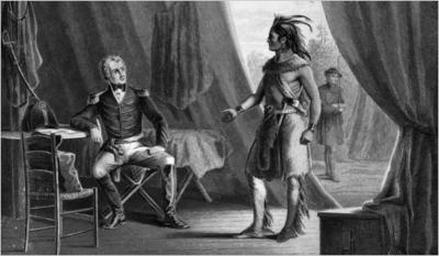Historical Context
"The Government of the United States are determined that their Administration of Indian Affairs shall be directed entirely by the great principles of Justice and humanity." - President George Washington
European settlement caused conflict with Native Americans over the idea of land ownership. After the Revolutionary War, President Washington believed they could be “civilized” and assimilate into American culture. He accepted the declaration in the U.S. Constitution that native tribes were sovereign nations ordering Henry Knox, Secretary of War, to make treaties. Native American borders were to be recognized and power given to establish and impose their own laws. As the United States began to expand during the Jefferson administration in the early 1800’s, attitudes began to focus on racial differences and policy shifted toward removal (Perdue), prompting Native Americans to side with the British during the War of 1812. In 1814, Andrew Jackson defeated the Creek at Horseshoe Bend. The Creeks lost 22 million acres of land in a peace agreement. Following the war, the government became more determined to remove native tribes from the southeast. Jackson negotiated 9 of 11 treaties between 1814-1824, dismantling tribal territory.
|
"The Indians being the prior occupants, possess the right of the soil. It cannot be taken from them unless by their free consent, or by the right of conquest in case of a just war. To dispossess them on any other principle, would be a gross violation of the fundamental laws of nature, and of that distributive justice which is the glory of a nation."
-Henry Knox, Secretary of War 1789-1794 |
"Whole nations melt away like snowballs in the sun....The white man has surrounded us, leaving only a little spot of ground to stand upon and it seems to be their intention to destroy us as a nation."
- Dragging Canoe, Indian warrior |
“In this way our settlements will gradually circumscribe and approach the Indians and they will in time either incorporate with us as citizens of the United States or remove beyond the Mississippi. The former is certainly the termination of their history most happy for themselves, but, in the whole course of this, it is essential to cultivate their love. As to their fear, we presume that our strength and their weakness is now so visible that they must see we have only to shut our hand to crush them, and that all our liberalities to them proceed from motives of pure humanity only.” - President Thomas Jefferson
Theda Perdue, 10 Apr. 2016, YouTube

